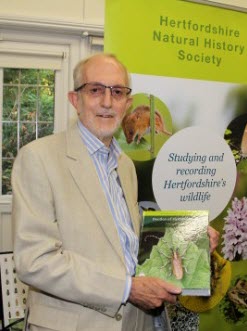Forty Hertfordshire Natural History Society (HNHS) members and beetle enthusiasts gathered at the headquarters of the Royal Entomological Society near St Albans on the evening of 31 July to celebrate the publication of Trevor James’ landmark book Beetles of Hertfordshire. A second, daytime event at Rye Meads Visitor Centre (by kind permission of the RSPB Manager) on 10 August brought together more beetles fans, keen to have their copies signed by the author.
Trevor’s 496-page book is the first publication to not only list all the species that have been reliably recorded in a single county, but also provide tetrad-level distribution maps and photographs for the more commonly recorded species as well as habitat information. The book describes 2,483 species that had been recorded at the time it went to press. These include many records contributed by Trevor himself during 40 years as county recorder.
However – as Trevor explained at the Royal Entomological Society launch – another seven new species have been recorded since then, including two located by his wife, Chris, in the previous week! He added that this only underlined the need for continued recording effort and fuller understanding of the contribution that beetles make to understanding climate change and other ecological health issues.
It was a particular pleasure to welcome Bryan Sage, Trevor’s predecessor as Hertfordshire Coleoptera recorder and a past-President of the HNHS, to the launch. Trevor presented him with a signed copy of the new book, noting that it was Bryan who had compiled all previous records before handing over the recording role. You can see images from the launch on the HNHS website.
Advice from Trevor

Trevor will be known to many within the NBN as he was the NBN Development Officer for many years. We contacted him regarding the successful launch of his book, to pass on our congratulations and to ask if he would be happy for us to cover it on the NBN website and in Network News. Trevor was more than happy for us to do so, but was keen to get across some key points in relation to taking on such an undertaking:
1. Any account like that is only possible with the full support of a host of people and their willingness to submit good quality records, including detailed associated habitat data for each occurrence (backed up where necessary with specimens and/or high quality photos).
2. Making records (or taking photos) is the easy bit. The hard slog is the systematic collation of all the data, the identification of often difficult material and a lot of leg-work researching other sources of information.
3. The real value of bringing all this together is also to try and get the information in a form that people can use, without sacrificing the detail. So, my introductory sections were partly aimed at getting non-specialists to see how beetle (and other insect) data can be used to focus minds on environmental protection processes, land management issues etc.
4. Finally, a key theme across the book is that beetles, like many insect groups don’t just ‘live in’ habitats – they are a fundamental part of ecological processes, and if we understand these better, we have a better chance of enhancing the natural world.
